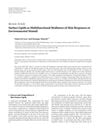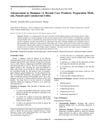TLDR A new growth medium doubles Malassezia restricta yield by using artificial sebum.
The study developed a new artificial sebum-containing modified Leeming and Notman agar medium (mLNA) to enhance the growth of Malassezia species, which are lipophilic fungi. By replacing olive oil with artificial sebum and Tween 60 with glyceryl stearate, the researchers achieved higher yields of Malassezia spp. Notably, the yield of Malassezia restricta, the most predominant fungus on human skin, was doubled compared to the standard mLNA. This advancement could improve the cultivation and study of these fungi.
4 citations
,
October 2021 in “Microorganisms” Men with androgenetic alopecia have different scalp oils and microbes compared to those without.
 January 2023 in “Postępy Dermatologii i Alergologii”
January 2023 in “Postępy Dermatologii i Alergologii” Azelaic acid treats acne, rosacea, and hyperpigmentation with minimal side effects.
241 citations
,
August 2005 in “Journal of Investigative Dermatology Symposium Proceedings” Dandruff and seborrheic dermatitis are caused by yeast feeding on scalp oils, leading to irritation and flaking.
 105 citations
,
January 2010 in “Mediators of Inflammation”
105 citations
,
January 2010 in “Mediators of Inflammation” Skin surface lipids are important for skin health and altering them could help prevent aging and treat skin conditions.
14 citations
,
September 2021 in “International journal of molecular sciences” Zinc pyrithione needs targeted delivery to the scalp for effective dandruff treatment.
 12 citations
,
February 2014 in “Recent Patents on Inflammation & Allergy Drug Discovery”
12 citations
,
February 2014 in “Recent Patents on Inflammation & Allergy Drug Discovery” Shampoos have evolved into multifunctional products with patented innovations for different hair needs and can include medicinal herbs for hair and scalp health.


